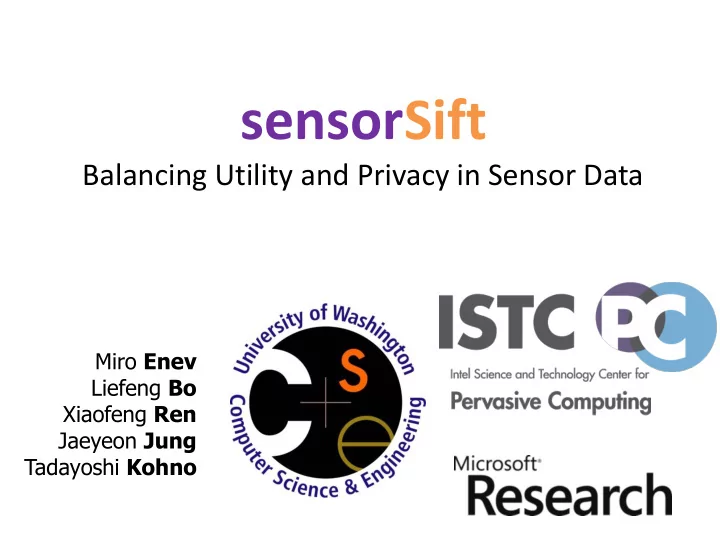

sensorSift Balancing Utility and Privacy in Sensor Data Miro Enev Liefeng Bo Xiaofeng Ren Jaeyeon Jung Tadayoshi Kohno
Rise of {Sensors + AI} • People expect rich computational experiences to be available in every context • As a result, our world is increasingly visible to intelligent computers – Minimal cost of sensors – Cheap computational power – Advances in machine reasoning & inference. • There are many positive aspects of these trends – Increased Productivity & Connectivity • However there are also potential negative effects – Privacy Risks
Lack of Balance • There are many benefits of smart-sensor applications – Increased Productivity, Connectivity, and Interactivity • However there are also potential negative effects – Privacy Risks
Goals • Develop a quantitative framework for balancing privacy and utility in smart sensing applications. – Empower users with privacy guarantees – Applications retain functionality • Evaluate the quality of our framework against state of the art machine inference • Offer a flexible solution so that the future demands of users/applications can be supported
Usage Model 1 Sensor data releases to smart applications are often risk carrying Common Practice: Sensor releases all of the raw data to an Application (e.g. MS Kinect) Sensor :{ 1 sensor data } App :{ 2 feature extract, 3 classify, 4 logic}
Usage Model 1 Sensor data releases to smart applications are often risk carrying Common Practice: Sensor releases all of the raw data to an Application (e.g. MS Kinect) Sensor :{ 1 sensor data } App :{ 2 feature extract, 3 classify, 4 logic} ++ INNOVATION - PRIVACY
Usage Model 2 Sensor data releases to smart applications are often arbitrarily stifling Common Practice: Only a predefined set of features is available to an Application (e.g., iOS) Platform :{ 1 sensor data , 2 feature extract, 3 classify } App :{ 4 logic}
Usage Model 2 Sensor data releases to smart applications are often arbitrarily stifling Common Practice: Only a predefined set of features is available to an Application (e.g., iOS) Platform :{ 1 sensor data , 2 feature extract, 3 classify } App :{ 4 logic} - INNOVATION ++ PRIVACY
Solution • Users choose what attributes to keep private • Applications can request non-private ( public ) attributes – Public attributes can be invented!
Solution • Users choose what attributes to keep private • Applications can request non-private ( public ) attributes POLICY – Public attributes can be invented! • We transform (sift) sensor data to reveal the public but hide the private attributes Plat . : { 1 sensor data, 2 sift features } App { 3 classify, 4 logic} + INNOVATION + PRIVACY
Evaluation Context ATTRIBUTES: visually describable characteristics about a face
System Overview Scenario: • USER : I don’t want apps. to have knowledge about my race and gender • APPLICATION: Is the user smiling ? > POLICY: PRIVATE {race, gender}, PUBLIC {smiling} System: 1. Generates Sift 2. Verifies Sift 3. Applies Verified Sift
System Overview Scenario: • USER : I don’t want apps. to have knowledge about my race and gender • APPLICATION: Is the user smiling ? > POLICY: PRIVATE {race, gender}, PUBLIC {smiling} System: 1. Generates Sift 2. Verifies Sift 3. Applies Verified Sift RUNTIME
Generating Sifts database Intuitively, sifting finds the safe region(s) in feature space which are in the public feature set B but not in the private one A . feature regions are based on a large database of sensor samples A = eyewear (private) B = gender (public) gender eyewear safe region
Generating Sifts Intuitively, sifting finds the safe region(s) in feature space which are in the public feature set B but not in the private one A . A = eyewear (private) B = gender (public) Safe region(s) may not always exist for certain attribute correlations.
Sifting Details PPLS X = Raw Features X’ = Sifted Features 𝑌 𝑜 , 𝑜 > 100𝑙 sift 𝑌′ 𝑜 , 𝑜~5 Y+ = labels of public attribute(s) Y- = labels of private attribute(s)
Performance Metrics A successful sift will have low scores on both PubLoss and • PrivLoss PubLoss : Decrease in sifted public attribute classification accuracy relative to – the achievable accuracy using raw (unsifted) data. PrivLoss : Gain in sifted private attribute classification accuracy relative to – chance. *Classifiers : Linear Support Vector Machine (SVM), Non-Linear SVM, Neural Network, Random Forest, kNearest Neighbors
Dataset & Attributes PubFig Database ~ 45,000 face images of 200 celebrities, 72 attributes Attributes are [binary] labels for visually describable characteristics, Attribute Clusters Attractive Female Wavy Hair Arched Eyebrows Wearing Lipstick Blond Hair Youth Male - M, Attractive Female - AF, White - W, Youth - Y, Smiling - S, Frowning - F, No Eyewear - nE, Obstructed Forehead - OF, No Beard - nB, and Outdoors - O.
Results
Results
Results
M - Male F - Attr. Female W - White Y - Youth S - Smiling F - Frowning public attribute nE - No Eyewear OF - Obstr. Forehd. nB - No Beard O - Outdoors private attribute
Conclusions • We proposed a theoretical framework for quantitative balance between utility and privacy though policy based control of sensor data exposure. • In our analysis we found promising results when we evaluated the PPLS algorithm in the context of automated face understanding. • The algorithm we introduce is general, as it exploits the statistical properties of the data; and in the future it would be exciting to evaluate SensorSift in other sensor contexts. • Available as Open Source! miro@cs.washington.edu
Thanks! Liefeng Xiaofeng Jaeyeon Yoshi SecLab @ UW
Questions? http://homes.cs.washington.edu/~miro/ sensorSift
Recommend
More recommend